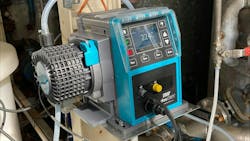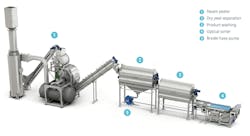How food and beverage processors can improve water efficiency with the right pump
As food and beverage processors strive for better water management in their production processes, selecting the right pump has become increasingly important. If a processor can reduce its water usage then less water needs to be treated, which produces cost savings while also meeting environmental and sustainability standards.
By 2030 demand for water will outstrip supply by 40% as the world’s growing population drives water consumption, according to McKinsey, a global management consultant firm. Climate change is also putting pressure on water availability.
Food and beverage processing requires large volumes of water, which is not as cheap as it once was in some countries, while water is a scarce resource in other parts of the world. One way a food and beverage processor can address its own water consumption is to consider if its existing pump, or one it is about to purchase, has these capabilities:
- Accuracy, which avoids chemical overdosing and achieves cost savings.
- Precise dosing under changing process conditions.
- Ability to pump dewatered waste sludge.
- Simple pump design for ease of cleaning.
More companies adopt water reuse
When agricultural produce enters a plant for processing, it uses vast volumes of water which must meet specific requirements for different uses such as washing and preparation, pasteurization, cleaning of equipment, steaming and sterilization, and as an additive or stabilizer.
To reuse water in food production, it is necessary to treat it, which involves a significant energy requirement, along with building the necessary infrastructure, chemical usage and labor. At the end of the process, a waste stream is also produced, in the form of sludge, which can pollute the environment if poorly managed.
For this reason, wastewater must undergo high levels of treatment prior to discharge. Companies that opt to treat wastewater onsite, rather than through a trade effluent service, are expected to meet ever-tightening environmental standards before emission to watercourses.
Water reuse is becoming increasingly popular in the food and beverage sector, with companies adding new treatment trains to minimize use of municipal water and reduce abstractions from, and discharges to, the environment.
Accurate dosing makes a difference
In the competitive food and beverage market, standards for health and safety and environmental compliance are of critical importance. But choosing the right chemical dosing pump can mitigate risks from breaches in health and safety and compliance.
Eurial, the France-based milk division of the AGRIAL cooperative group, supplies dairy products to shops, catering and commercial companies. At Eurial’s Quincampoix dairy in Normandy, a single Qdos CWT (Conveying Wave Technology) dosing pump now treats the 300m3 of water needed to feed the entire plant daily after it replaced a diaphragm pump.
The site has its own well for its supply of running water, which is used in the production process and for cleaning of equipment. This water requires chlorination for disinfection and daily quality control. Eurial relies on the Qdos CWT peristaltic pump, from Watson-Marlow Fluid Technology Solutions (WMFTS), for accurate and reliable chlorine dosing.
The dosage is from 0 to 800 mL/h depending on the pump settings and the drawing flow rate of the installations with a back pressure varying from 3 to 4 bar. The pump adapts its flow rate automatically according to the water consumption.
Previously, Eurial experienced problems with a diaphragm pump, which was sensitive to the aggressiveness of chlorine and led to de-priming, clogged valves and clogged suction pipes. As a result, the dosage was not constant and regularly generated non-conformities regarding the chlorine level. In the first half of 2022, Eurial observed 40 non-conformities and 32 interventions, an average of 5.3 interventions and 6.7 non-conformities per month.
Qdos peristaltic chemical metering pumps provide highly accurate dosing by enabling precise, incremental adjustments. They can handle applications requiring dosing at 0.1 mL/min, right up to 2,000 mL/min. By only using what is needed, chemical quantities and costs are reduced. The Qdos range of pumps requires virtually no ancillary equipment and the patented pumphead can be replaced quickly and easily without tools, for fast and safe maintenance.
Since adopting the Qdos CWT, Eurial has succeeded in obtaining FSSC 22000 certification, a scheme for Food Safety Management Systems.
By adopting best-practice for process water and wastewater treatment and plant cleaning, and by identifying opportunities for water efficiency at every stage of the process, food and beverage processors can move towards more sustainable practices. As new process priorities and requirements come into operation, Qdos dosing pumps have the flexibility to meet a range of requirements including new types of chemicals, value for money, reliability and ease of maintenance.
Across the world, legally binding environmental regulations, such as the European Water Framework Directive, the U.S. Clean Water Act, and the Australian National Water Initiative are in place to protect rivers, lakes, estuaries, coastal waters and groundwater from pollution.
Food and beverage companies in breach of water quality requirements risk prosecutions, large fines and even having their discharge permits revoked. Appropriate chemical treatment of process water and wastewater is fundamental to the safe and efficient operation of all food and beverage production plants.
Efficient cleaning
It is essential that all machinery, water and wastewater systems are accurately maintained and cleaned with trained personnel that follow procedures and ensure effective operating processes. The most efficient plants choose a combination of preventative, proactive, and predictive approaches and WMFTS designs dosing equipment to these high standards. Its pumps are easy to install, operate and maintain, and will help minimize the procedural load and the risk of human error.
Pumps that are easy to clean are also important in striving for better water efficiency.
Apart from agriculture, the biggest water use in the food industry is the cleaning of processing equipment/plants and food products, which can account for up to 70% of a factory’s water usage[1], but clean-in-place (CIP) is one way of reducing water usage for food and beverage companies.
Using a Certa 200 Sine pump and Aflex FaBLINE hose, from WMFTS, has not only increased yield for Padstow Cheese Company in England, but also reduced the amount of time and water used in cleaning.
Lawrence Reynolds, of Padstow Cheese Company, said: “The Certa pump is so easy to clean, unlike our previous centrifugal pump, which was a nightmare. In addition, the smooth construction of Aflex FaBLINE hoses means we can flush the cleaning products through and rinse out very easily.”
Reducing food waste with less water use
Peristaltic pumps from WMFTS have also been integrated into sustainable solutions for steam potato peeling provided by TOMRA Food which reduces water usage, water treatment and food waste.
The TOMRA Dry Peel Separator (DPS) uses a Bredel hose pump as a dry-waste pump which enables food processors to reduce water usage and recover the potato skin and starch for use in animal feed or anaerobic digestion (biogas).
Eamonn Cullen, Market Manager Peeling at TOMRA Food, says Bredel plays a key role in TOMRA’s sustainable solution for an efficient, reliable and profitable potato peeling solution.
Cullen says: “There are a number of advantages with using the Bredel hose pump. The ability to pump peel without the addition of water is one. The majority of potato processing facilities will collect all steam peeled skin in dry form. Some processors still need to use water in the peel separation brush machines, but this is reducing every year. It has become an important key performance indicator for the food industry to reduce water usage, to reduce food waste and to improve sustainability.
Collecting the steam peeled skin and starch dry enables this material to be used in other parts of the value chain. It can be farmers feeding animals or anaerobic digesters changing biomass into biogas. These opportunities help maximize the utilization of every part of the potato and make every potato count.”
Conclusion
Food and beverage companies are achieving better water management with water reuse, by adding new treatment trains to minimize use of municipal water and reduce abstractions from, and discharges to, the environment.
During water treatment, selecting the right chemical dosing pump can mitigate risks from breaches in health and safety and compliance. Using a peristaltic metering and dosing pump can achieve not only chemical cost savings through its accuracy, but also contributes to better water conservation for food and beverage companies.

